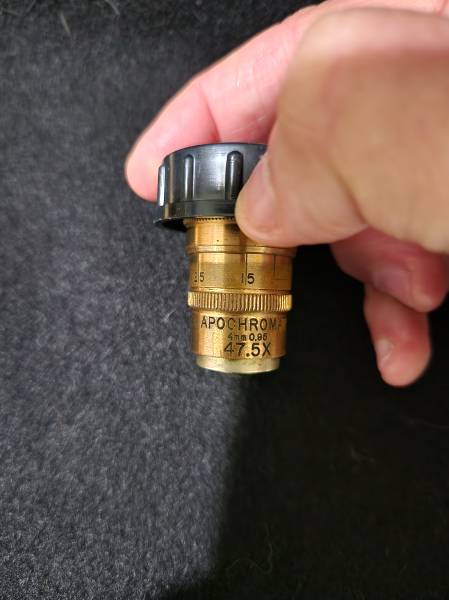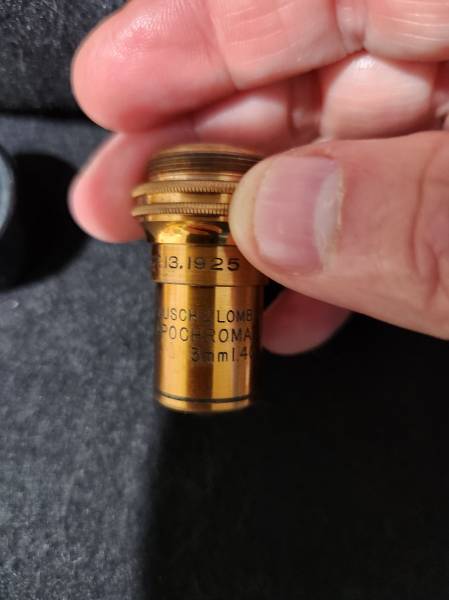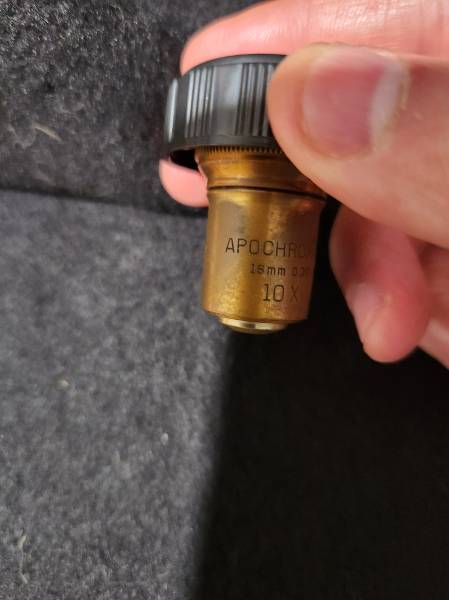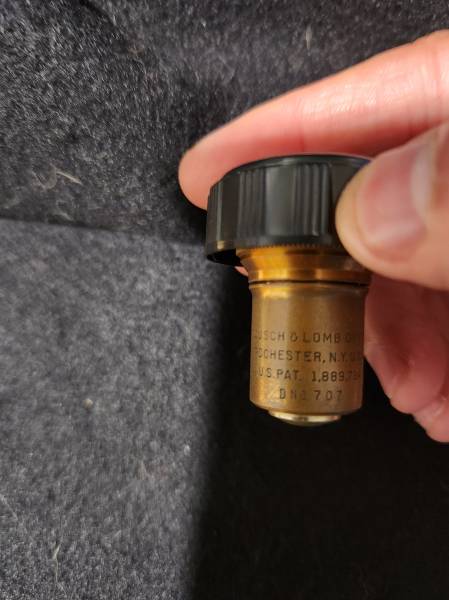Have a problem finding shops that sell specific materials? Ask here. Are you looking for microscope parts? Do you have anything to offer for sale? Note: this is not a section for external companies to advertise their products.
-
einman
- Posts: 1509
- Joined: Tue Feb 24, 2015 1:03 am
#1
Post
by einman » Tue May 16, 2023 3:55 pm
Hello,
I am cleaning out my lab. I will be posting pics quickly (meaning not taking a lot of time for lighting etc) some with prices some with make an offer as I have no idea of their value. Feel free to weigh in on what you think they are worth if no price listed.
Here are some B&L objectives 10x APO, 47.5x APO, 61x OEL:

The collar moves freely and the optics are good.

Optics good

Optics good

Optics good

Optics good
There are 2 10x apos on Ebay listed for north of $200 which I believe is absurd. Make an offer.
-
apochronaut
- Posts: 6356
- Joined: Fri May 15, 2015 12:15 am
#2
Post
by apochronaut » Wed May 17, 2023 7:16 am
It never ceases to amaze me how so many really mediocre 160mm achromat microscopes are sold, yet really excellent 160mm apochromats get limited notice. If one has sn extra 9mm focus travel on a microscope with even a 1.25 N.A. abbe condenser, these are an opportunity to raise the bar on your image quality. A 1.25 oil abbe condenser isn't ideal but it is close enough to get excellent results, if not quite the superb results that a 1.4 N.A. condenser would yield.
You will need compensating eyepieces. I am pretty sure those Olympus Bi. W.F. 10X will do it. with an 18mm f.o.v. too.
The quantiyy of those objectives is starting to thin out.
-
einman
- Posts: 1509
- Joined: Tue Feb 24, 2015 1:03 am
#3
Post
by einman » Wed May 17, 2023 2:19 pm
Thanks Apochronaut. I wouldn't be selling them, or anything for that matter, if I were not limited on space. It amazes me how truly beautiful the image is on many of the older model scopes.
-
viktor j nilsson
- Posts: 761
- Joined: Thu Aug 23, 2018 10:12 pm
- Location: Lund, Sweden
#4
Post
by viktor j nilsson » Wed May 17, 2023 2:51 pm
These are 160mm, right? Do you know the eyepiece pickup point? This data is missing from my go-to reference, Die Mikrofibel. (I'm just curious, not looking to expand my collection...)
-
apochronaut
- Posts: 6356
- Joined: Fri May 15, 2015 12:15 am
#5
Post
by apochronaut » Thu May 18, 2023 1:08 am
160mm, 11mm eyepiece focal length, 36.67 mm parfocal which goes back into the 19th century and is a modern conversion of 1 57/128". The reason for that is obscure. Olympus pilfered the parfocal length at some point after W.W. II, likely due to U.S. occupation and their need for microscope lenses. A good guess is that
B & L sold them optics for a while until they got their feet on the ground after being bombed and they kept and developed the system until converting to 45mm parfocal. Those B & L apochromats would work handily on a Galen 1 OR Olympus microscopes that used shorty objectives with little adaption. Their forté though, is in an older B & L research stand or a tricked out Dynazoom, one of the great overlooked microscopes.
Apochromats up until probably the early 60's infinity corrected AO 10X .30 and 43X .85 always needed different eyepieces than achromats. The reason has to do with the necessity to achieve apochromatism by correcting for ca. In doing so, sa is undercorrected. The system design in order to balance ca and sa corrections involved overcorrection of ca in order to correct for sa. The ca overcorrection was handled easier than undercorrected sa in the eyepiece and could be accomodated for by purposely ca undercorrecting eyepieces or what are called compensating eyepieces. They might as easily be called reverse correcting .
Only after the very early introduction of the AO infinity apochromats around 1963, which used the same eyepieces for achromats and apochromats did the design of general use eyepieces begin to take place with other manufacturer's apochromat designs. Improved low dispersion glass formulas were the advantage necessary in order to align the overall corrections of achromats and apochromats alike. Eyepieces used could be correcting to neutral to compensating, depending on the overall design parameters of the objective family. Early AO stuff was almost neutral, wheras B & L 1970's flat field designs required slightly compensating eyepieces.
 The collar moves freely and the optics are good.
The collar moves freely and the optics are good. Optics good
Optics good Optics good
Optics good Optics good
Optics good  Optics good
Optics good